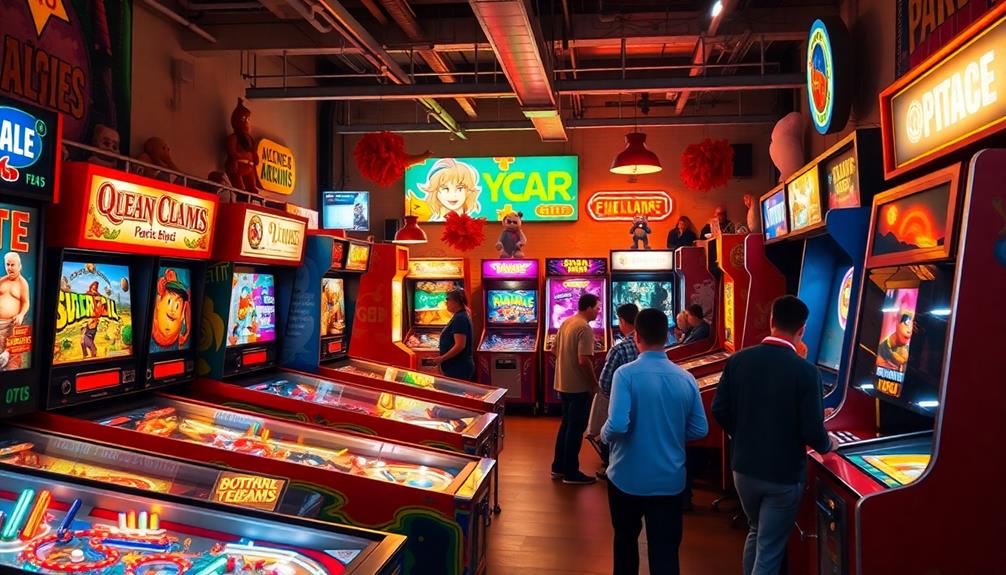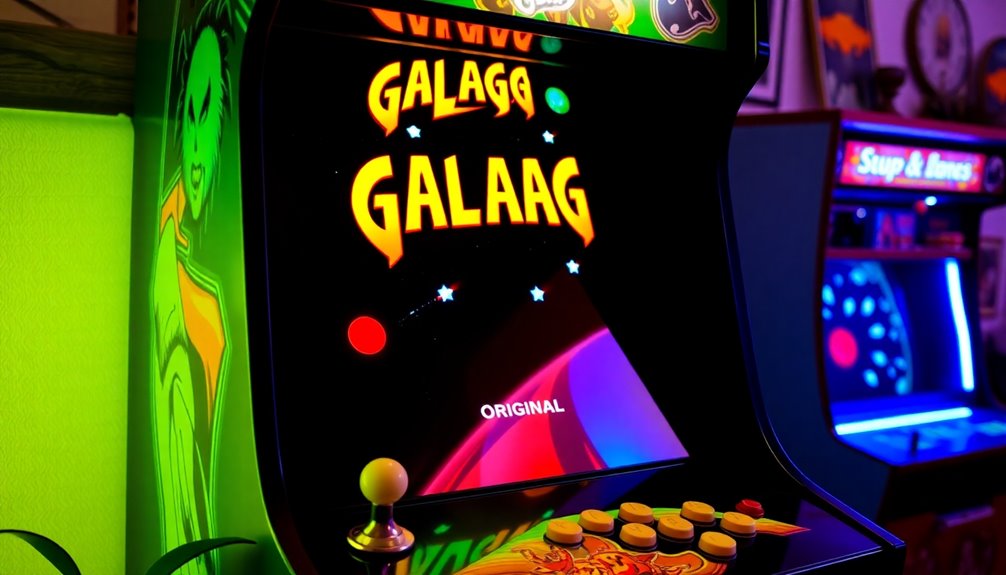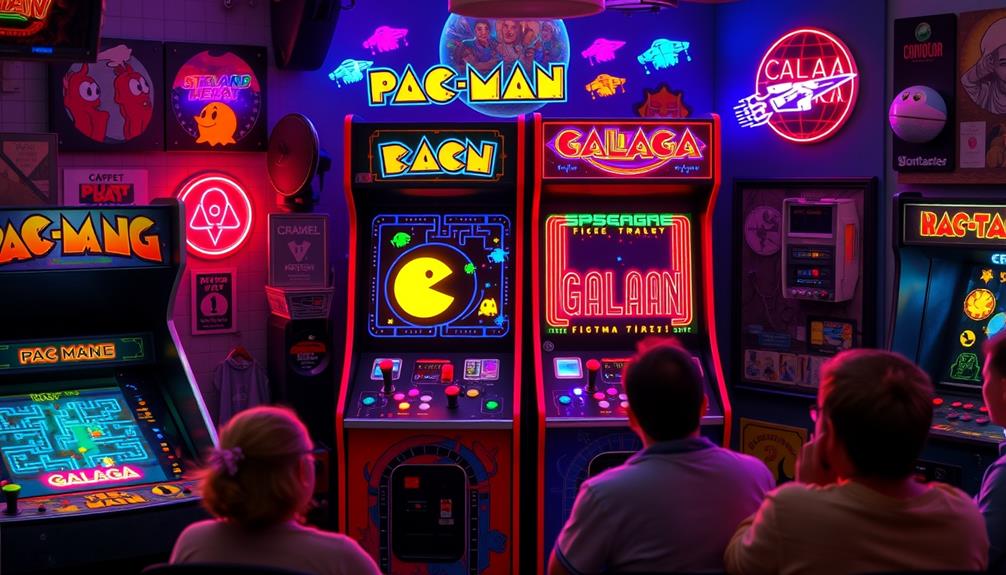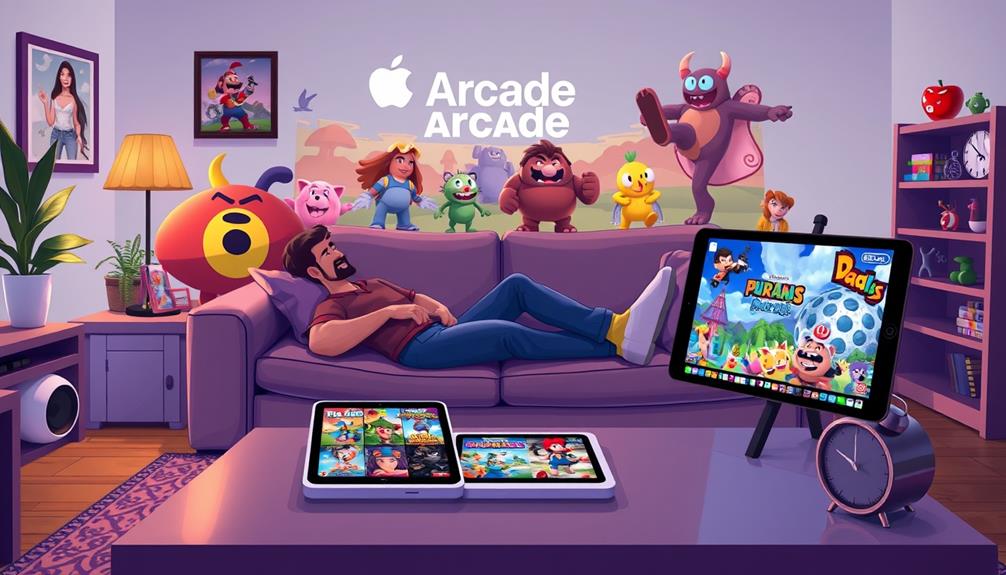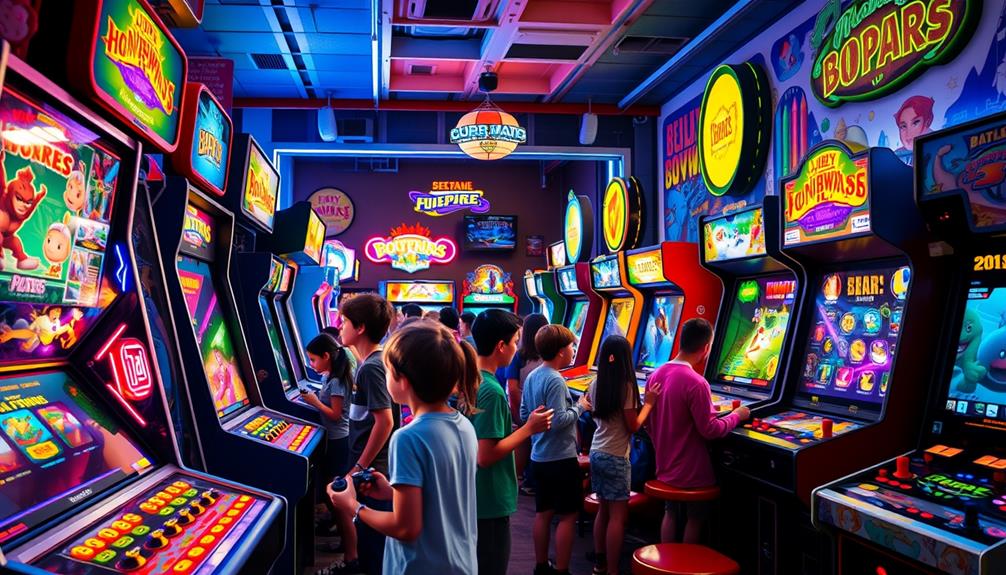When you step into an arcade, you are welcomed by a lively assortment of games to suit every preference. Test your skills with classic fighting games such as “Street Fighter II” or compete against your friends in “Daytona USA.” For a chance to win prizes, try your hand at redemption games like Basketball Shootout or claw machines. You can also dive into captivating action titles like “Pac-Man” and “Donkey Kong” that have had a significant impact on the gaming world. With a wide variety of options to choose from, there is always something new to discover and enjoy. Stay a while, and you may stumble upon even more fascinating gaming experiences!
Key Takeaways
- Arcade games include various types such as video games, redemption games, merchandiser games, and competitive play, catering to diverse player preferences.
- Popular genres encompass action games like "Street Fighter II," racing games like "Daytona USA," and redemption games like Basketball Shootout.
- Iconic titles like "Pac-Man," "Donkey Kong," and "Galaga" have significantly influenced arcade gaming and established genre standards.
- Modern trends include virtual reality integration, multiplayer experiences, and themed environments to enhance player engagement in arcades.
- Notable manufacturers like Sega and Atari have shaped arcade gaming's legacy and continue to innovate with new titles and technologies.
Overview of Arcade Game Types
Arcade games offer a thrilling escape into entertainment, and they come in three main types: video games, redemption games, and merchandiser games.
Arcade video games focus on providing fun and competition without any prizes. You might find yourself playing classic arcade games like Pac-Man or Space Invaders, which laid the groundwork for today's gaming experiences, much like how the best rated pinball machines of 2024 showcase exciting gameplay and advanced technology.
Redemption games, on the other hand, reward you with tickets or prizes based on your performance. You'll enjoy popular games like Stop the Wheel and various sports-themed options, which add an element of excitement as you aim to score big.
Merchandiser games give you a chance to win direct prizes from the machine. Claw machines are a favorite, alongside photo booths and bulk vending machines, offering a tactile thrill as you try to snag your desired item.
For those who enjoy competitive play, you might gravitate toward fighting games or even air hockey and mini bowling, which cater to different preferences while still being part of the arcade atmosphere.
Each type of game contributes to the vibrant and varied arcade experience, ensuring there's something for everyone.
Popular Arcade Game Genres
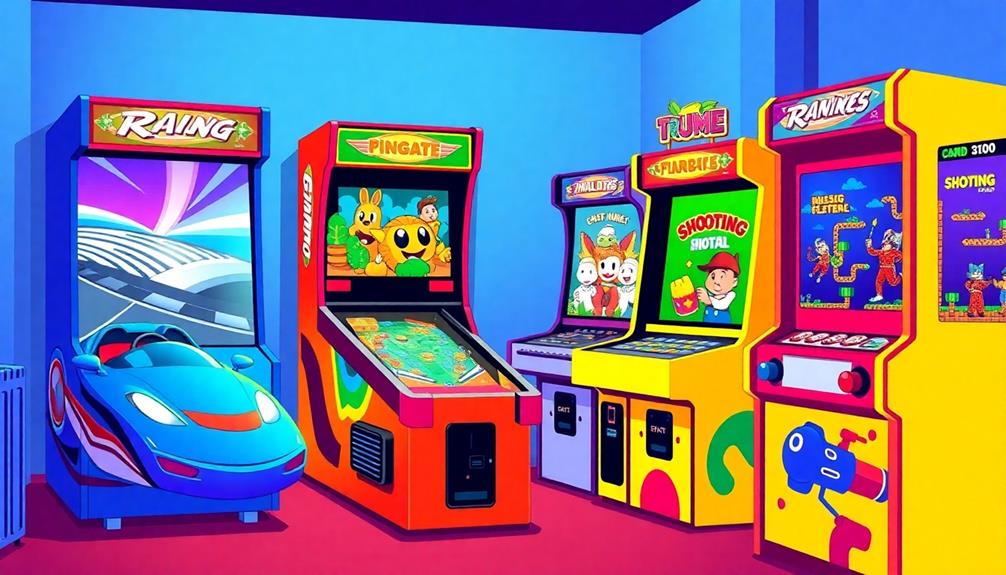
When you step into an arcade, you'll quickly notice the diverse genres that cater to various tastes and preferences. Among these, the action genre stands out, featuring arcade classics like "Street Fighter II" and "Mortal Kombat II." These games have not only defined the genre but also attracted countless players with their engaging gameplay.
Racing games also hold a prominent place in arcades. Titles like "Daytona USA" and "SEGA Rally Championship" deliver thrilling competition, allowing you to race against friends or the clock. Meanwhile, redemption games add a different twist, rewarding you with tickets or prizes based on your performance. These games enhance player engagement, making them a favorite for all ages.
| Genre | Popular Titles | Unique Features |
|---|---|---|
| Action Genre | Street Fighter II, Mortal Kombat II | Fast-paced, competitive gameplay |
| Racing Games | Daytona USA, SEGA Rally Championship | Thrilling driving experiences |
| Redemption Games | Basketball Shootout, Whac-A-Mole | Rewards and prizes for skill |
These genres create a vibrant atmosphere, ensuring there's something for everyone in your local arcade.
Iconic Arcade Games and Their Impact
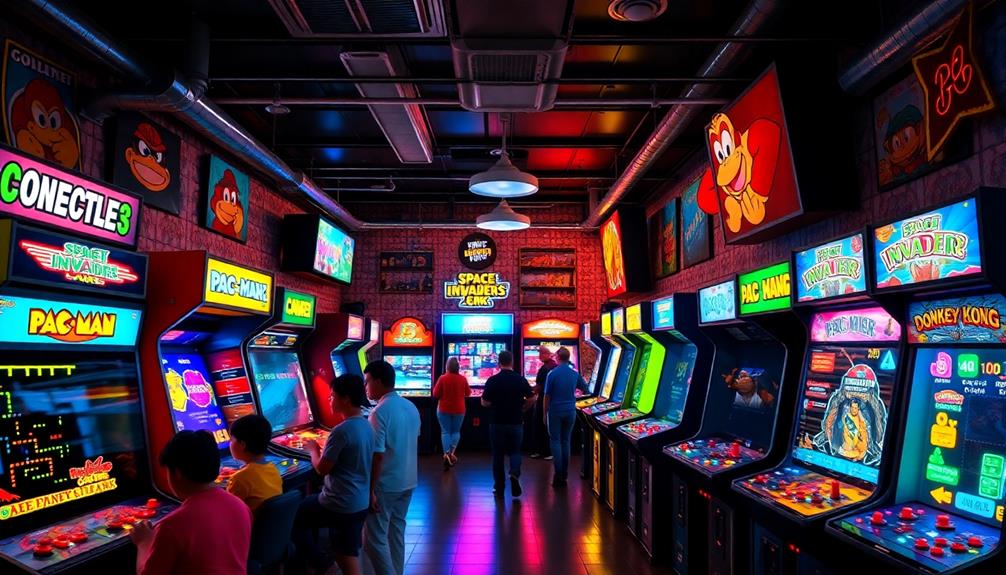
Often regarded as the backbone of arcade gaming, iconic titles like "Pac-Man" and "Donkey Kong" have left an indelible mark on the industry. "Pac-Man," released in 1980, not only pioneered the maze chase genre but also introduced unique gameplay mechanics that influenced countless future games.
Similarly, "Donkey Kong," arriving a year later, marked Mario's first appearance, establishing a precedent for platform games and igniting interest in competitive gaming. In a way, these early games laid the groundwork for community culture and player engagement, much like how celebrity relationships evolve and inspire connections among fans and celebrities.
Moving into the 1990s, "Street Fighter II" emerged as one of the best arcade games of all time, introducing accessible special moves and a cast of characters that became legends in their own right. This classic fighting game greatly shaped the genre and inspired many sequels and spin-offs.
Other iconic arcade games, like "Galaga," enhanced fixed shooter gameplay with innovative mechanics, while "Dance Dance Revolution" popularized rhythm action, encouraging physical activity in a fun way.
These titles not only defined the arcade experience but also shaped the gaming landscape, influencing game design, player engagement, and community culture for years to come. Their impact continues to resonate, reminding you of the enduring legacy of these classic games.
Notable Manufacturers and Developers
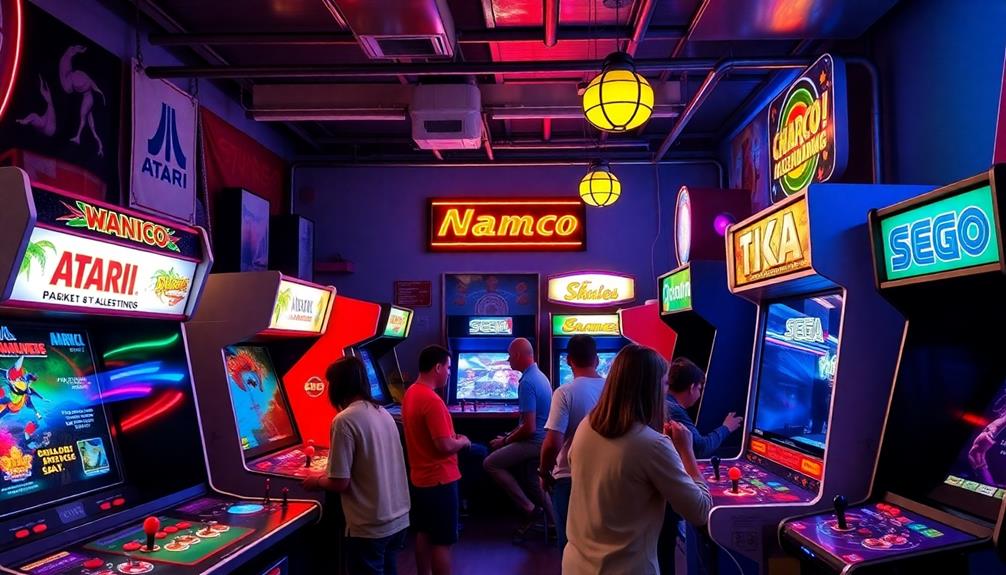
Numerous manufacturers and developers have greatly shaped the arcade gaming landscape, creating a vibrant industry that thrives on innovation and collaboration. During the Golden Age of arcade gaming, companies like Sega and Atari Games emerged as powerhouses, markedly influencing the popularity of arcade machines.
Sega, in particular, is renowned for its proprietary hardware platform, NAOMI, which powered several successful titles that captured players' imaginations. The evolution of technology, including the introduction of modern pinball machines, has also influenced arcade gaming, showcasing the dynamic interplay between different gaming formats.
Collaboration between developers and publishers has also been key to the industry's success. For instance, Aicom developed "A.B. Cop," published by Sega, showcasing how teamwork can lead to exciting new experiences for gamers. Similarly, Midcoin's creation of "A.D. 2083" reflects the diversity in game development that different companies bring to the table.
With a staggering total of 949 developers and publishers contributing to arcade games, it's clear that this industry thrives on a collaborative spirit. Each entity plays an essential role in pushing the boundaries of what arcade machines can offer, ensuring that the legacy of the Golden Age continues to inspire future innovations in gaming.
Trends in Arcade Gaming Today
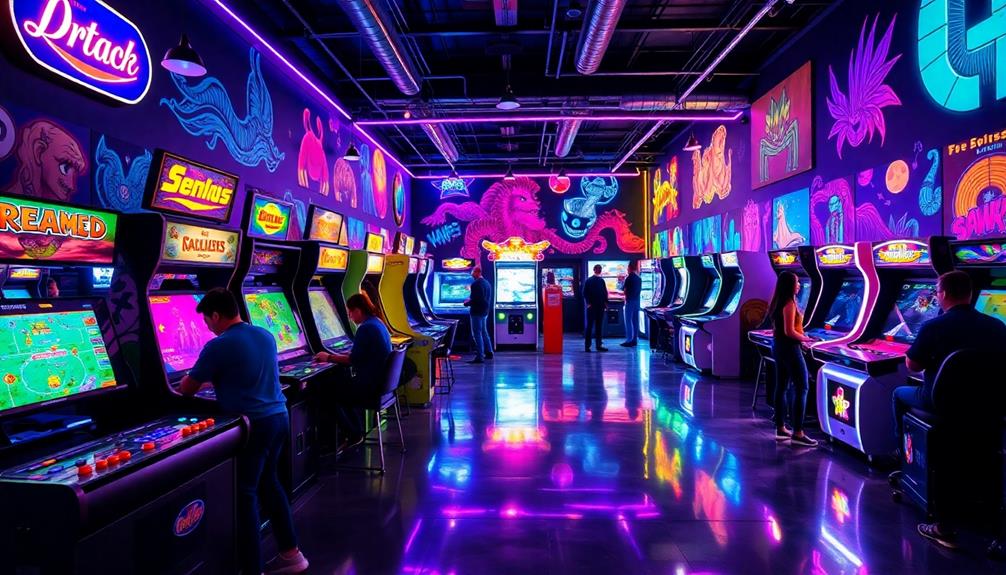
In today's arcade landscape, trends are evolving rapidly to meet the demands of tech-savvy players. The integration of virtual reality (VR) technology has transformed traditional arcade action, offering immersive gaming environments that pull you into vibrant, interactive worlds.
Additionally, the rise of accessible home gaming options, such as best arcade machines for home game rooms, is influencing arcade designs to cater to both casual and dedicated gamers. This trend is attracting a broader audience, enthusiastic for new experiences beyond the retro arcade games of the past.
Here are three key trends shaping the future of arcade gaming:
- Multiplayer Experiences: Platforms like Hologate and Omni Arena are on the rise, promoting social interaction and engagement among players. You can team up or compete with friends, adding a layer of excitement to your gaming sessions.
- Themed Environments: Arcades are increasingly focusing on creating themed, immersive spaces that enhance customer engagement. These environments make your gaming experience feel unique and memorable.
- E-sports Integration: The rise of e-sports is reshaping arcade culture, bringing large audiences to competitive gaming events. This trend not only boosts excitement but also encourages repeat visits as you participate in or watch thrilling competitions.
With these trends, the future of arcades looks bright and promising!
Frequently Asked Questions
What Is the Most Common Arcade Game?
When you think about the most common arcade game, you might instantly picture classics like "Pac-Man" or action-packed ones like "Street Fighter II." These iconic titles have captured players' hearts and defined the arcade experience for decades.
How Many Types of Arcade Games Are There?
Arcade games are like a treasure chest, full of different experiences. There are three main types: Video games, Redemption games, and Merchandiser games, each offering unique ways for you to play and enjoy. Video games are the classic and most well-known types of arcade games, offering players a chance to test their skills in a wide variety of game genres such as racing, shooting, and platforming. Redemption games, on the other hand, provide players with the opportunity to win tickets or prizes through various challenges and skill-based activities, adding an element of competition and reward to the arcade experience. Lastly, Merchandiser games allow players to try their luck at winning various trinkets and prizes, often with the use of a claw or crane mechanism. All three types of arcade games offer something different and exciting for players of all ages to enjoy.
What Games Are Played at an Arcade?
When you visit an arcade, you'll find a mix of action-packed games, racing simulators, classic titles, and interactive experiences. Whether you prefer fighting games or redemption challenges, there's something exciting waiting for you.
Which Is the Best Arcade Game?
While opinions vary, you'll often find that Street Fighter II stands out as the best arcade game. Its revolutionary mechanics and diverse characters not only shaped the genre but also keep players engaged even today.
Conclusion
In the vibrant world of arcade gaming, you can see how these machines not only entertain but also forge connections among players. Just as a well-crafted game captures your attention, it also holds a mirror to society's evolving tastes. Whether you're chasing high scores or reliving nostalgia, the arcade experience remains timeless. So, step up to the joystick and immerse yourself—because every game you play is a journey waiting to be explored.
